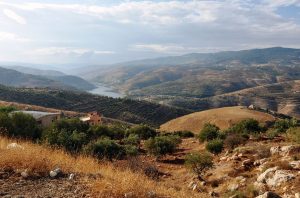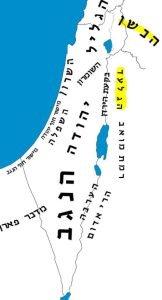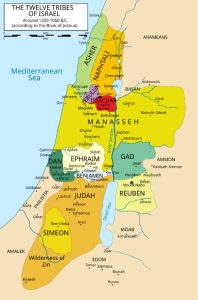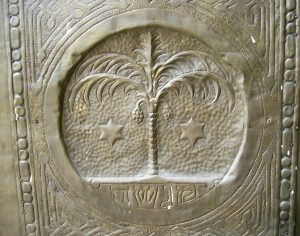How many Yairs does it take to conquer a territory? No, this isn’t a variation on the age-old light bulb question but a thought when reading our Gemara which mentions Yair the son of Seguv:
“And from where did Yair have land that his father, Seguv, did not have? Rather, this teaches that Yair married a woman who inherited her father’s land, and she died and he inherited from her” (Bava Batra 112a)
This Yair, from the tribe of Manasseh, is mentioned in the book of Chronicles, where we are told about his large land holdings:
“And Seguv begot Yair, who had twenty-three cities in the land of Gilead” (I Chronicles 2:22).
Probing a bit deeper into the background of the tribe of Manasseh yields many Yairs, each one responsible for part of the tribal inheritance:
“Yair son of Manasseh went and captured their villages, which he renamed Havvot-Yair.” (Bamidbar 32:41)
“Yair son of Manasseh received the whole Argob district (that is, Bashan) as far as the boundary of the Geshurites and the Maacathites, and named it after himself: Havvot-Yair —as is still the case.” (Devarim 3:14)
“After him arose Yair the Gileadite, and he led Israel for twenty-two years. He had thirty sons, who rode on thirty burros and owned thirty boroughs in the region of Gilead; these are called Havvot-Yair to this day.” (Judges 10:3)
The towns of Havvot Yair are also mentioned in a number of other places:
“and all of Havvot-Yair in Bashan, sixty towns;” (Joshua 13:30)
“Ben-geber, in Ramoth-gilead—he governed Havvot- Yair son of Manasseh that are in Gilead, and he also governed the district of Argob that is in Bashan, sixty large towns with walls and bronze bars;” (Melachim I 4:13)
Even more interesting, all these verses are similar but not identical. We hear about a Yair the son of Manasseh (Bamidbar, Devarim) Yair the son of Seguv (Chronicles) and Yair the Gileadi (Judges). Sometimes he has twenty-three cities (Chronicles) sometimes sixty (Joshua) and sometimes thirty (Judges). All the cities are on the eastern side of the Jordan but even there we have variations, sometimes the properties are in Gilead (Chronicles, Bamidbar, Judges) sometimes in Bashan (Devarim, Joshua) and sometimes both (Kings).
Is this all one person with various nicknames? Or, more likely since the stories span a period from the Exodus to King Solomon, the name of a revered ancestor and his descendants? While we cannot definitively answer that question, we can understand where this land is and perhaps how the tribe of Manasseh came to inherit it.
The Gilead is on the eastern side of the Jordan. It reaches from the land of Moav in the south to the Golan in the north. Many important figures in Jewish history came from there, including the judges Yair and Yiftah the Gileadites and the prophet Elijah the Gileadite. It remained a Jewish area through Second Temple times, although it was sometimes controlled by other nations. In the nineteenth century the Christian Zionist Lawrence Oliphant explored it and wanted to settle Jews there and make it a Jewish state.

Jim Greenhill, U.S. Army, Public domain, via Wikimedia Commons
The Bashan is further north, in what we know as the Golan. Both these territories were ruled by fierce kings, Sihon and Og, and were strongly fortified:
“all those towns were fortified with high walls, gates, and bars—apart from a great number of unwalled towns.” (Devarim 3:5)

משתמש:Yanivreg, CC BY-SA 3.0 <http://creativecommons.org/licenses/by-sa/3.0/>, via Wikimedia Commons
How did Manasseh inherit this huge area? The story of Manasseh in Transjordan is a fascinating puzzle. If you read Bamidbar chapter thirty-two carefully, you will see that until almost the end of the chapter the only tribes asking Moses for land in the east are Gad and Reuven. Moses chastises them for abandoning the people, makes very strict rules for them and in general seems very angry at their request (see here). And then, at the very end of the story appears the tribe of Manasseh:
“The descendants of Machir son of Manasseh went to Gilead and captured it, dispossessing the Amorites who were there; so Moses gave Gilead to Machir son of Manasseh, and he settled there.” (Bamidbar 32:39-40)
Unlike the other two tribes, the people of Manasseh are not admonished by Moses. They conquer their cities and settle their land with little fuss. It seems like there is a natural progression to their story, unlike the disruption caused by Gad and Reuven.

https://upload.wikimedia.org/wikipedia/commons/c/c2/12_Tribes_of_Israel_Map.svg
Professor Yoel Elitzur in his book Places in the Parsha looks at this story through the lens of an anonymous commentator known only as a student of Rav Saadia Gaon. This student, using the many unusual mentions of Yair and Machir the sons of Manasseh, says that the tribe of Manasseh went to the Gilead and Bashan while the children of Israel were in Egypt and conquered these lands. They were able to do so because their father, Joseph, was a powerful ruler in Egypt and Egypt controlled the whole area at the time. Another commentary, Rabbi Judah the Hasid, writes how his father explained a similar idea about the tribe of Ephraim, who also have a cryptic passage in the book of Chronicles:
“His [Ephraim’s] daughter was Sheerah, who built both Lower and Upper Beth-horon, and Uzzen-sheerah.”(Chronicles 1 7:20)
Ephraim’s daughter built cities in the area that would eventually belong to her tribe, many generations before Joshua’s conquest. Ephraim and Manasseh were able to leave Egypt and conquer land since they were princes, sons of the ruler Joseph. Later, after Joseph’s death, the Children of Israel were enslaved and these ancestral conquests had to be abandoned. But when they left Egypt and arrived in Gilead and Bashan forty years later, the tribe of Manasseh took back the land that had originally belonged to them. Unlike Gad and Reuven, who wanted land that they had no right to have, Manasseh was reclaiming his heritage.
Modern scholars like Rav Yaakov Medan and Rav Yoel Bin Nun take this idea a step further. They note that between the first census of the people, right after the Exodus, and the second, forty years later, there is a great discrepancy in the numbers of the tribe of Manasseh. While in the first census they numbered 32,200 people, in the second their population has jumped by twenty-thousand, to 52,700. Where did all those Manassites come from?
Rav Medan proposes a radical solution – not only did the tribe of Manasseh conquer the Gilead in the days of Joseph, some of them stayed there and never returned to Egypt. When the rest of the Israelites arrived in the Gilead and the Bashan they were amazed to discover these long-lost cousins. They quickly helped them get rid of their overlord Og and brought them into the covenant of God, uniting them with the rest of Israel.
Yair not only inherited land from his wife (mother?), he also reclaimed a heritage that had been his from generations earlier.

Symbol of the tribe of Manasseh by Zeev Raban
zeevveez from Jerusalem, Israel, CC BY 2.0 <https://creativecommons.org/licenses/by/2.0>, via Wikimedia Commons










